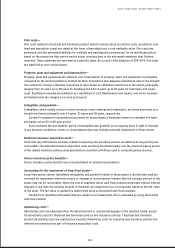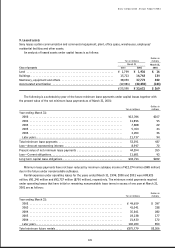Sony 2001 Annual Report Download - page 103
Download and view the complete annual report
Please find page 103 of the 2001 Sony annual report below. You can navigate through the pages in the report by either clicking on the pages listed below, or by using the keyword search tool below to find specific information within the annual report.
Sony Corporation Annual Report 2001
101
Film costs—
Film costs related to theatrical and television product (which includes direct production costs, production over-
head and acquisition costs) are stated at the lower of amortized cost or net realizable value. Film costs are
amortized, and the estimated liabilities for residuals and participations are accrued, for an individual product
based on the proportion that current period actual revenues bear to the estimated remaining total lifetime
revenues. These estimates are reviewed on a periodic basis. As a result of the adoption of SOP 00-2, film costs
are classified as non-current assets.
Property, plant and equipment and depreciation—
Property, plant and equipment are stated at cost. Depreciation of property, plant and equipment is principally
computed on the declining-balance method for Sony Corporation and Japanese subsidiaries and on the straight-
line method for foreign subsidiary companies at rates based on estimated useful lives of the assets, principally,
ranging from 15 years up to 50 years for buildings and from 2 years up to 10 years for machinery and equip-
ment. Significant renewals and additions are capitalized at cost. Maintenance and repairs, and minor renewals
and betterments are charged to income as incurred.
Intangibles and goodwill—
Intangibles, which mainly consist of artist contracts, music catalogs and trademarks, are being amortized on a
straight-line basis principally over 16 years, 21 years and 20 years, respectively.
Goodwill recognized in acquisitions accounted for as purchases is being amortized on a straight-line basis
principally over a 20 or 40-year period.
Sony evaluates the amortization period of intangibles and goodwill on an ongoing basis in light of changes
in any business conditions, events or circumstances that may indicate potential impairment of those assets.
Deferred insurance acquisition costs—
Costs that vary with and are primarily related to acquiring new insurance policies are deferred as long as they are
recoverable. The deferred insurance acquisition costs are being amortized mainly over the premium-paying period
of the related insurance policies using assumptions consistent with those used in computing policy reserves.
Future insurance policy benefits—
Future insurance policy benefits are computed based on actuarial assumptions.
Accounting for the impairment of long-lived assets—
Long-lived assets, certain identifiable intangibles, and goodwill related to those assets to be held and used are
reviewed for impairment whenever events or changes in circumstances indicate that the carrying amount of the
assets may not be recoverable. When the sum of expected future cash flows (undiscounted and without interest
charges) is less than the carrying amount of the asset, an impairment loss is recognized, based on the fair value
of the asset. The fair value of goodwill is determined using a discounted cash flows analysis.
Goodwill not identified with assets that are subject to an impairment loss is evaluated by using discounted
cash flow method.
Advertising costs—
Advertising costs are expensed when the advertisement or commercial appears in the selected media, except
for advertising costs for theatrical and television product and insurance policies. Theatrical and television
product advertising costs are expensed as incurred. Advertising costs for acquiring new insurance policies are
deferred and amortized as part of insurance acquisition costs.
























